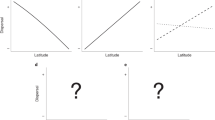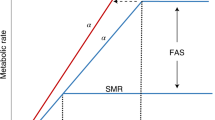Abstract
Understanding how larvae from extant hydrothermal vent fields colonize neighbouring regions of the mid-ocean ridge system remains a major challenge in oceanic research1,2. Among the factors considered important in the recruitment of deep-sea larvae are metabolic lifespan, the connectivity of the seafloor topography, and the characteristics of the currents3. Here we use current velocity measurements from Endeavour ridge to examine the role of topographically constrained circulation on larval transport along-ridge. We show that the dominant tidal and wind-generated currents in the region are strongly attenuated within the rift valley that splits the ridge crest, and that hydrothermal plumes rising from vent fields in the valley drive a steady near-bottom inflow within the valley. Extrapolation of these findings suggests that the suppression of oscillatory currents within rift valleys of mid-ocean ridges shields larvae from cross-axis dispersal into the inhospitable deep ocean. This effect, augmented by plume-driven circulation within rift valleys having active hydrothermal venting, helps retain larvae near their source. Larvae are then exported preferentially down-ridge during regional flow events that intermittently over-ride the currents within the valley.
This is a preview of subscription content, access via your institution
Access options
Subscribe to this journal
Receive 51 print issues and online access
$199.00 per year
only $3.90 per issue
Buy this article
- Purchase on Springer Link
- Instant access to full article PDF
Prices may be subject to local taxes which are calculated during checkout




Similar content being viewed by others
References
Tunnicliffe, V. The biology of hydrothermal vents: Ecology and evolution. Oceanogr. Mar. Biol. Ann. Rev. 29, 319–407 (1991)
van Dover, C. L., German, C. R., Speer, K. G., Parson, L. M. & Vrijenhoek, R. C. Evolution and biogeography of deep-sea vents and seep invertebrates. Science 295, 1253–1257 (2002)
Marsh, A. G., Mullineaux, L. S., Young, C. M. & Manahan, D. T. Larval dispersal potential of the tubeworm Riftia pachyptila at deep-sea hydrothermal vents. Nature 411, 77–80 (2001)
Kelley, D. S., Delaney, J. R. & Lilley, M. D. Vent field distribution and evolution along the Endeavour segment, Juan de Fuca Ridge. EOS Trans. AGU 82 47, F612 (2001)
Stahr, F. R., McDuff, R. E., Yoerger, D. R., Bradley, A. M. & Nakamura, K. Heat flux measurements at the Main Endeavour vent field. Juan de Fuca Ridge. Eos Trans. AGU (Fall Mtg Suppl. Abstr) 81(48), (2000) OS52I-03
Cannon, G. A. & Thomson, R. E. Characteristics of a 4-day oscillation trapped by the Juan de Fuca Ridge. Geophys. Res. Lett. 23, 1613–1616 (1996)
Mihaly, S. F., Thomson, R. E. & Rabinovich, A. B. Evidence for nonlinear interaction between internal waves of inertial and semidiurnal frequency. Geophys. Res. Lett. 25, 1205–1208 (1998)
Lavelle, J. W. & Cannon, G. A. On subinertial oscillations trapped by the Juan de Fuca Ridge, northeast Pacific. J. Geophys. Res. 106, 31099–31116 (2001)
German, C. R. & Sparks, R. S. J. Particle recycling in the TAG hydrothermal plume. Earth Planet. Sci. Lett. 116, 129–134 (1993)
Murton, B. J., Redbourn, L. J., German, C. R. & Baker, E. T. Sources and fluxes of hydrothermal heat, chemicals and biology within a segment of the Mid-Atlantic Ridge. Earth Planet. Lett. 171, 301–317 (1999)
Thurnherr, A. M., Richards, K. J., German, C. R., Lane-Serff, G. F. & Speer, K. G. Flow and mixing in the Rift Valley of the Mid-Atlantic Ridge. J. Phys. Oceanogr. 32, 1763–1778 (2002)
McDuff, R. E. in Physical, Chemical, Biological, and Geological Interactions within Seafloor Hydrothermal Systems (eds Humphris, S. E., Zierenberg, R. A., Mullineaux, L. S. & Thomson, R. E.) 357–368 (American Geophysical Union Monograph, Washington, 1995)
Veirs, S. R. Heat Flux and Hydrography at a Submarine Volcano: Observations and Models of the Main Endeavour Vent Field in the Northeast Pacific PhD thesis, Univ. Washington (2003)
Bemis, K. G., von Herzen, R. P. & Mottl, M. J. Geothermal heat flux from hydrothermal plume on the Juan de Fuca Ridge. J. Geophys. Res. 98, 6351–6369 (1993)
Ginster, U., Mottl, M. J. & von Herzen, R. P. Heat flux from black smokers on the Endeavour and Cleft segments, Juan de Fuca Ridge. J. Geophys. Res. 99, 4937–4950 (1994)
Baker, E. T. & Massoth, G. J. Characteristics of hydrothermal plumes from two vent fields on the Juan de Fuca Ridge, northeast Pacific Ocean. Earth Planet. Sci. Lett. 85, 59–73 (1987)
Rosenberg, N. D. et al. Estimation of heat and chemical fluxes from a seafloor hydrothermal vent field using radon measurements. Nature 334, 604–607 (1988)
Thomson, R. E., Delaney, J. R., McDuff, R. E., Janecky, D. R. & McClain, J. S. Physical characteristics of the Endeavour Ridge hydrothermal plume during July 1988. Earth Planet. Sci. Let. 111, 141–154 (1992)
Lupton, J. E., Delaney, J. R., Johnson, H. P. & Tivey, M. K. Entrainment and vertical transport of deep-ocean water by buoyant hydrothermal plumes. Nature 316, 621–623 (1985)
Acknowledgements
We thank the IOS Mooring Group of T. Juhász and D. Spear for successful deployment and recovery of all instruments; K. Conley and D. Andrie of the Oceans Division of Fisheries and Oceans Canada for helping fund the moorings; A. Lee for assisting with the data processing; and P. Kimber for assisting with the figures. This work was partially supported by a Natural Sciences and Engineering Research Council (NSERC) grant and National Science Foundation (NSF) grant.
Author information
Authors and Affiliations
Corresponding author
Ethics declarations
Competing interests
The authors declare that they have no competing financial interests.
Rights and permissions
About this article
Cite this article
Thomson, R., Mihály, S., Rabinovich, A. et al. Constrained circulation at Endeavour ridge facilitates colonization by vent larvae. Nature 424, 545–549 (2003). https://doi.org/10.1038/nature01824
Received:
Accepted:
Issue Date:
DOI: https://doi.org/10.1038/nature01824
This article is cited by
-
Geothermal heating and episodic cold-seawater intrusions into an isolated ridge-flank basin near the Mid-Atlantic Ridge
Communications Earth & Environment (2021)
-
Caldera formation and varied eruption styles on North Pacific seamounts: the clastic lithofacies record
Bulletin of Volcanology (2014)
-
A novel trigger-based method for hydrothermal vents prospecting using an autonomous underwater robot
Autonomous Robots (2010)
Comments
By submitting a comment you agree to abide by our Terms and Community Guidelines. If you find something abusive or that does not comply with our terms or guidelines please flag it as inappropriate.



